Wheatcroft Long Sea Outfall (2017)
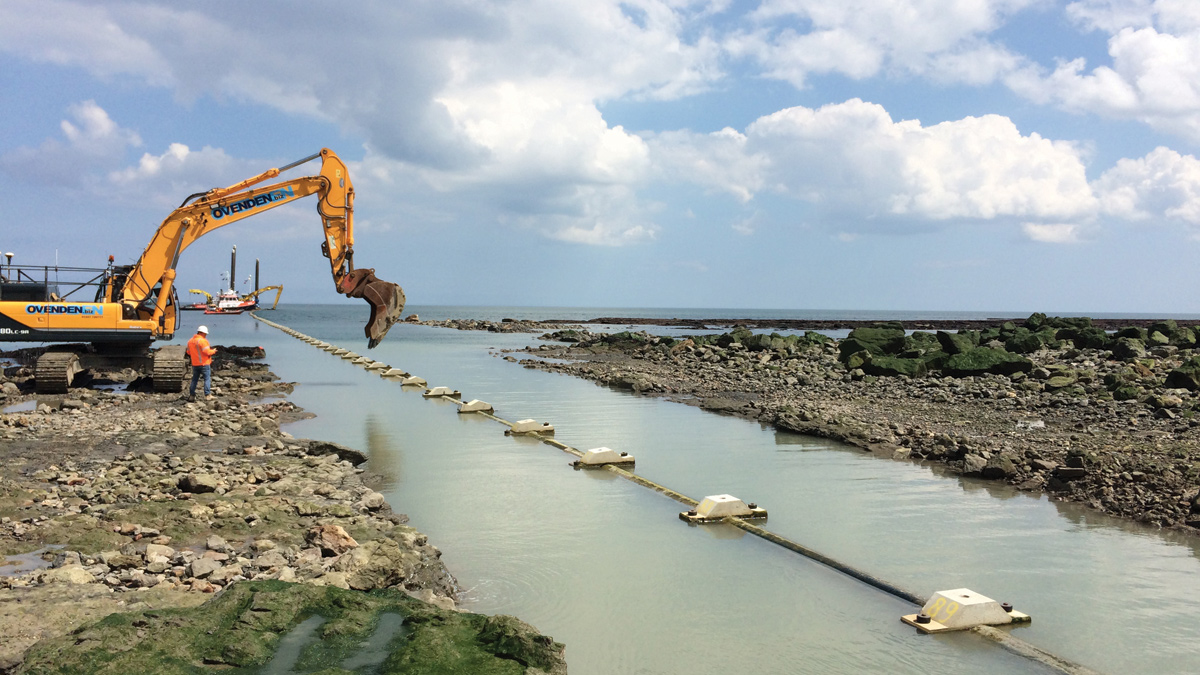
Outfall pipe installation - First 500m string sinking procedure - Courtesy of Royal HaskoningDHV
August 2016 saw the successful completion of a new 2.5 kilometre long sea outfall pipeline on the east coast of Yorkshire, South of Scarborough. The purpose of the project was to replace an existing corroded and collapsed steel outfall pipe with a new solid wall polyethylene (PE) pipeline. The installation required meticulous planning by a team of marine experts working on behalf of Yorkshire Water Services to continue the company’s vital work to protect water quality of the seas and beaches of the east coast.
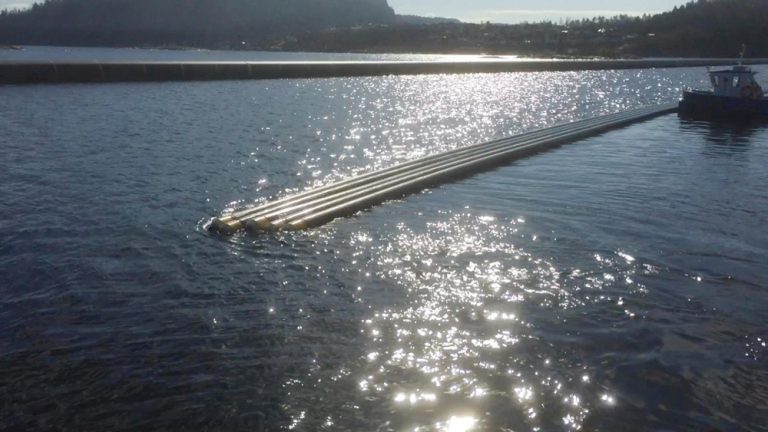
Pipe delivery by sea to Teesport – Courtesy of Pipelife Norge AS
Background
The Wheatcroft site is located approximately 3km south of Scarborough, a resort town on England’s North Sea coast which developed due to its popularity during the Victorian period. Scarborough currently has a population of 61,000 and is considered the largest holiday resort on the Yorkshire coast. The existing Wheatcroft Long Sea Outfall (LSO) is owned by Yorkshire Water Services and discharges treated effluent from a food processing factory. A separate storm water overflow is located in proximity to the LSO which discharges screened storm flows from the local catchment.
The existing LSO has failed on several occasions previously and is considered to be no longer serviceable. Any future failures of the existing outfall could result in a loss of the assets ability to discharge, impacting on the upstream factory and putting at risk Bathing Water quality at Scarborough. Therefore, full replacement of the outfall was considered to be necessary to meet both the functional needs and environmental requirements for the future.
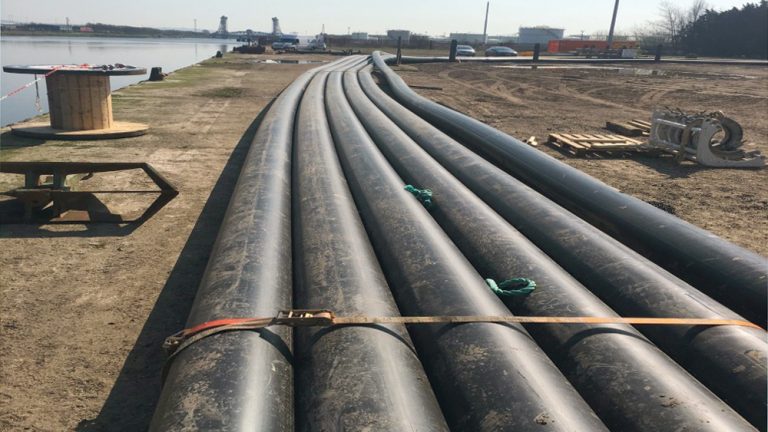
Pipe storage at Teesport – Courtesy of Royal HaskoningDHV
A stakeholder group was formed in 2013 to undertake a feasibility study and to conduct associated water quality studies to assess various treatment and marine outfall options that would satisfy the operational and environmental standards. A replacement LSO of 2500m in length discharging into water deeper than the existing was identified as the most environmentally sustainable solution and was supported by the regulating bodies. Construction of a replacement outfall was therefore submitted as part of the Price Review (PR14) for implementation during AMP6.
Existing outfall
The existing long sea outfall was constructed circa 1997. The landward portion of the pipeline consists of a 3.2km length of PE pipe which runs from the factory to the cliff top close to the Wheatcroft Pumping Station and a 300m length of 280mm diameter PE pipe which runs below a cliff path from the clifftop to the foreshore. The marine section of the existing long sea outfall consists of a 273mm outer diameter steel pipe with concrete protective coat and is laid in a trench and buried beneath the seabed. It outfalls approximately 2km from the shore. The sea bed level at the outfall diffuser is approximately -15mCD.
The Wheatcroft Pumping Station is not connected to the long sea outfall as its purpose is to transfer flows from the local catchment for treatment in Scarborough. There is also an existing 630mm diameter PE storm water outfall adjacent to the long sea outfall which discharges at low water and provides an overflow from the Wheatcroft Pumping Station.
The existing steel long sea outfall pipe was considered to be in poor condition and ongoing deterioration resulting in localised failures. A number of repairs have been undertaken to the marine pipe section over the last few years and the pipe was therefore considered to be at the end of its operational asset life and identified for complete replacement.
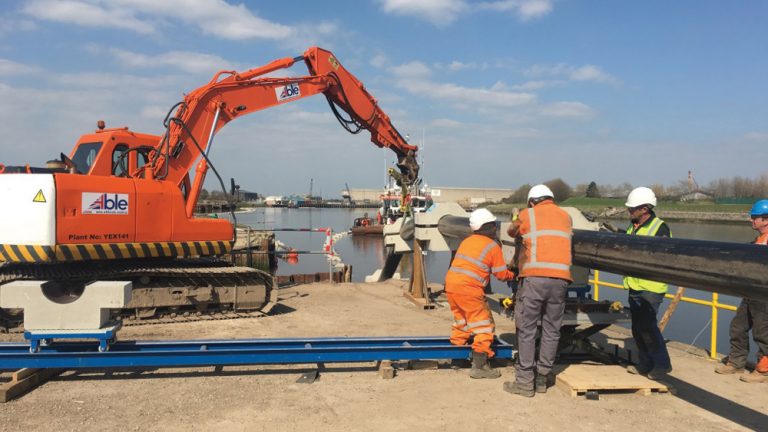
Collaring at Teesport – Courtesy of Royal HaskoningDHV
Solution
The concept design phase was undertaken in 2015. This considered and technically assessed a number of options including upstream treatment, patch repairs, internal re-lining and full offline replacement. The process identified a preferred solution that would function both hydraulically and structurally and this was to construct a replacement outfall parallel to the existing, comprising circa 2500m length of 355mm polyethylene pipe terminating in a 4-port diffuser. The outfall was proposed to be constructed off-line to allow existing discharges to continue prior to final connection above high water.
To combat flotation, the design proposed that the polyethylene pipe would be stabilised using a concrete weight collars to reduce buoyancy and enable controlled installation by sinking. In addition concrete mattresses to some sections of the trench were proposed to provide additional scour protection from storm conditions.
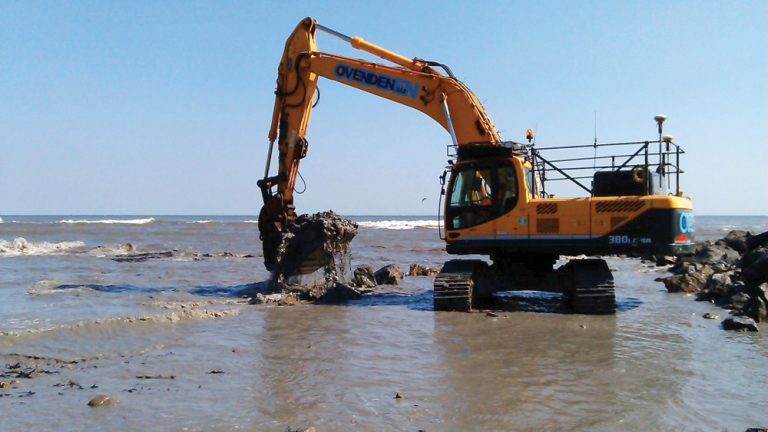
Nearshore trench excavation – Courtesy of Royal HaskoningDHV
Site investigation
Site Investigation information from 1996, prior to the previous outfall construction, was available and included land-based and overwater boreholes. Further site investigations were identified and specified by Royal HaskoningDHV. These included bathymetric and geophysical surveys to verify and correlate and confirm the existing along the proposed outfall. The early identification of the site data enabled Royal HaskoningDHV to reduce risks for Yorkshire Water Services in terms of unknowns that could occur during construction. This information also allowed the Contractors bidding to make a more informed estimate of the works.
The offshore investigation data that was obtained indicated that rock strata, comprising of various siltstone, sandstone, limestone and mudstone, were present at bed level up to approximately 500m from the shore. Further offshore the rock strata were overlain by superficial deposits of sand with occasional beds of gravel and cobbles to a depth of up to 6m below bed level. A borehole that had been carried out approximately 250m beyond the existing outfall diffuser indicated that the thickness of superficial deposits increases to approximately 12m at that location.
Constraints
The Wheatcroft Outfall Project is located in proximity to a residential area with limited space available for site compounds and storage. Access to the site was via residential roads which had width, time and day parking restrictions. The existing cliff path is steep and required improvement works to allow for access of land based plant. A Public Right of Way, The Cleveland Way, crosses the site at the top of the cliff and forms part of the cliff access which had to be maintained during the works duration.
Several rock outcrops known as White Nab, Raven Scar and Perilous Rock exist in the foreshore area in the vicinity of the outfall. The outfall also lies within the Cayton, Cornelian and South Bays of Special Scientific Interest (SSSI) and the Castle Ground Marine Conservation Zone. In addition, the works were undertaken with consent from the Marine Management Organisation (MMO).
Royal HaskoningDHV liaised directly and provided the input required for the construction consent application from the MMO to allow the works to be constructed. This application was expected to take a minimum of 3 months to approve and therefore an early application was sought and this was in place before contract award also saving Yorkshire Water Services time.
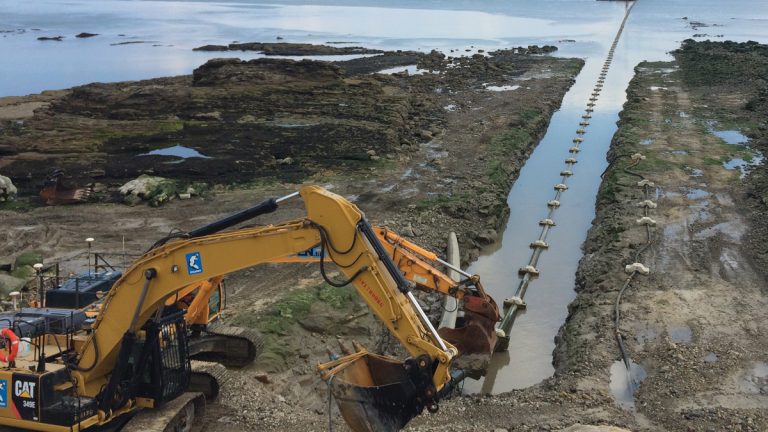
Outfall pipe installation – prior to flood procedure, courtesy of Royal HaskoningDHV
Design progression
Following completion of the concept design and specification by Royal HaskoningDHV, Van Oord UK successfully bid and were appointed in 2016 as principal contractor by Yorkshire Water Services to undertake the marine works on an EPC basis.
Van Oord produced a final design which involved the construction of a long sea outfall, diffuser structure and subsequent connection to the existing outfall pipeline on the foreshore. Stability and protection to the pipeline were provided through the use of 110kg per metre length fixed weight collars supplemented with 400mm OD/12mm thick PVC (cut sections) protective sleeves fitted over the outfall PE pipe in short lengths between the concrete collars.
The provision of this innovative sleeve proved to be a cost effective and best quality solution as it removed the need to use engineered backfill around the pipe through the rocky sections.
The use of engineered backfill would have required transportation by heavy dump trucks to the foreshore via the cliff access, causing disturbance to the environment and foreshore users, as well as increasing health and safety risks. The installation of 12mm thick PVC protective sleeves enabled excavated material to be re-used as backfill with minimal risk of damage to the pipe.
The design of the collars, in terms of its spacing and sizing, was optimised to provide consistent ballasting throughout the length of the pipeline assembly, enabling practical installation and ensuring long term pipe stability under all design conditions. Concrete mattresses were installed at the foreshore (breaking wave zone) section for scour protection purposes.
It was determined that the pipeline assembly would be towed out and sunk into position with all concrete collars pre-installed.
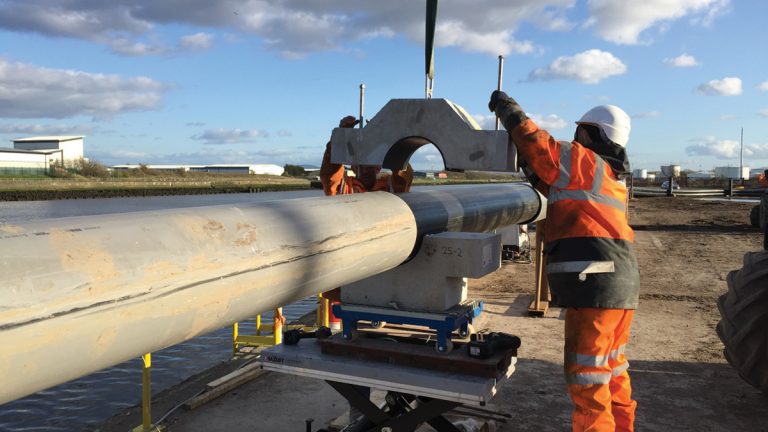
Installing concrete collars – Courtesy of Van Oord UK
Marine works
A total length of 2500m of polyethylene pipe (355mm OD SDR 17 PE100) was manufactured by Pipelife Norge AS, in lengths of 500m which were then towed to Teesport, Middlesbrough, UK for preparation and assembly.
The pipe strings were moved individually with the aid of excavators and small marine craft from the wet storage area into the working area within Teesport, where an assembly station was created for the fitting of protective sleeves, concrete collars and flanges.
As the site geology comprised of rocky seabed made up of mudstone and sandstone. Excavation through rock was required in sections of the outfall (between chainage 0m and 650m) and this was carried out using land based excavators on the beach section and backhoe dredger for the marine trench. A trailing suction hopper dredger (Volvox Olympia) was used for the excavation in the superficial deposits. A minimum cover of 1.5m above the crown of the pipe was required for the outfall pipeline through its entire route. The excavated trench material was cast adjacent to the trench for reuse as backfill material.
Installation
The PE pipelines were installed using the float and sink method. The installation started from the onshore end, where the pipe was positioned by means of an excavator on Wheatcroft Beach. The 500m long pipe strings were towed individually by a tug boat to the installation location and sunk to the seabed by pumping seawater in a controlled manner into the pipe.
The controlled pumping of seawater into the onshore pipe end, initiated the sinking process which caused the pipe to form an S-curve of approximately 50m long between the seabed and seawater surface. As a contingency measure and to ensure the installation process was well controlled, a foam pig was pre-installed in order to create a seal between the pipe section filled with air and the section filled with water, in case the pipe had to be re-floated.
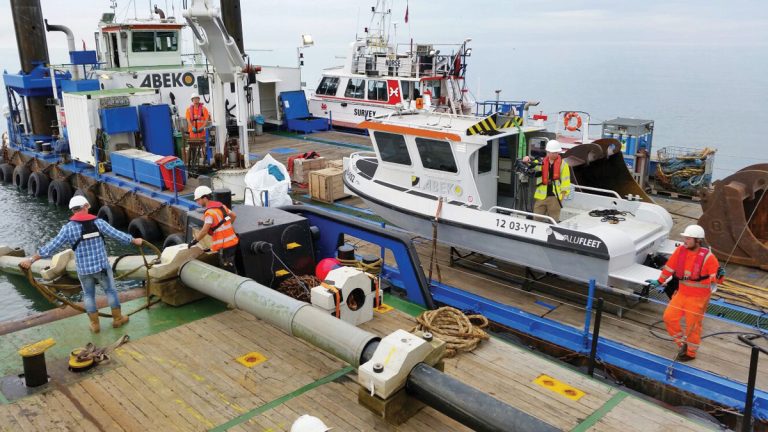
Outfall strings connected offshore by butt fusion welding – Courtesy of Van Oord UK
The 500m pipe sections were welded together on board the floating multi-cat vessel and, once in the trench, were checked with a multibeam survey using an RTK DGPS (target installation of +/- 3m horizontal, +/-0.5m vertical) to verify the pipe position.
Post pipe installation, the foam pig was removed from the pipe. A pressure test was performed on in accordance with the procedure set out in IGN 4-01-03, to 1.5 x the maximum internal working pressure.
Once the outfall pipeline had been sunk to the sea bottom and tested the diffuser was installed from the backhoe dredger platform by divers. The diffuser comprised a flanged PE pipe, fittings and a single riser with a four port crosshead, each a nominal 125mm outside diameter, allowing for Tideflex check valves to be fitted directly. Included as part of the diffuser installation, was a removable access flange at the top of the riser to enable access inside the riser pipe for future maintenance.
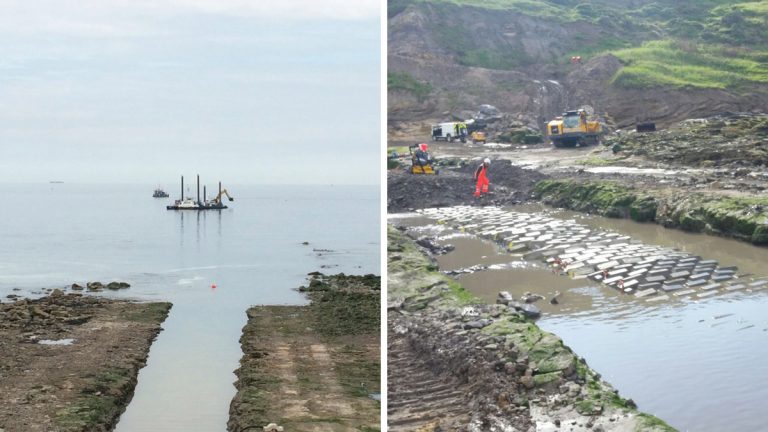
(left) Backhoe dredger during offshore dredging process – Courtesy of Royal HaskoningDHV and (right) Installation of concrete mattresses nearshore – Courtesy of Van Oord UK
A rock armour scour blanket extended approximately 8m around the diffuser from its centre to protect the area around the diffuser from scour. Also provided was a mild steel protection frame to the diffusers, fitted with sacrificial anodes to allow a 60 year design life.
The final connection to the existing outfall pipe was undertaken in July 2016 during a scheduled outage at the factory in which a spool piece was connected between the existing and newly installed pipelines using external couplings.
To complete the project and following successful commissioning the existing diffuser was removed and the existing outfall capped at both the onshore and offshore ends with concrete plugs.
Throughout the construction process Royal HaskoningDHV assisted Yorkshire Water Services by providing contractor checks, reviews and approvals of design submissions, temporary works, health and safety procedures, method statements, on site supervision, surveys and commissioning.
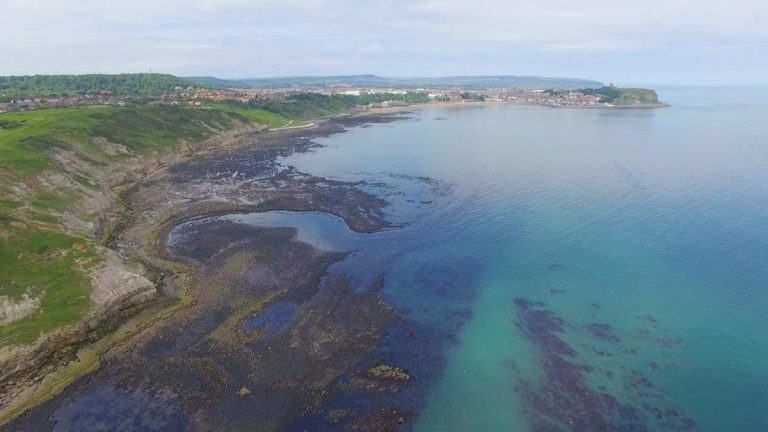
Wheatcroft Bay after completion of work – Courtesy of Van Oord UK
Conclusions
The successful completion of this project and the investment undertaken by Yorkshire Water Services will continue to provide water quality benefits to Wheatcroft, Scarborough and the Yorkshire coast.
The Wheatcroft Outfall Project is the first to be completed during AMP6 and further articles will appear in future editions of UK Water Projects.





